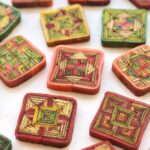Kek Lapis Sarawak: The Beautiful and Kaleidoscopic Layered Cakes
Kek Lapis Sarawak is a popular layered cake served in Sarawak, especially during festive occasions. It is more well known for its crazy layers of beautiful colours and kaleidoscopic designs, even though some Kek Lapis Sarawak are made with ordinary horizontal layers.
Kek Lapis Sarawak is a relatively new dessert. It was introduced by the Betawi people from Indonesia in the 1970s and 1980s, who brought their own Indonesian-Dutch fusion layer cake called Kek Lapis Betawi or Lapis Legit to Sarawak. The Sarawak people then added new ingredients, flavour and colour that resulted in a newer version layer cake, which then became Kek Lapis Sarawak. Plus, Sarawak Kek Lapis is also made using Western cake-making techniques.
Creating the intricate layers and designs of Kek Lapis Sarawak requires a meticulous process. The batter, made from flour, eggs, milk, butter, and various flavourings and colours, is baked in large pans in thin layers. A new thin layer of batter is added every few minutes, following a carefully calculated sequence for the arrangement of layers. The cake is then cut and reassembled, using condensed milk or jam as a binding agent. When the cake is sliced, its kaleidoscopic beauty is revealed in the cross-sections, showcasing the immense effort, imagination, attention to detail, and skill involved in its creation.
Since 2010, Kek Lapis Sarawak has been recognized as a protected geographical indication of Sarawak. This means that the term “Kek Lapis Sarawak” or “Sarawak Layer Cake” can only be used for cakes manufactured within Sarawak’s borders and according to the specifications set by the Sarawak Layer Cake Manufacturers Association. Producers outside the state can only legally refer to their products as “Sarawak-style” layer cake.
While Kek Lapis Sarawak was initially baked for special holidays such as Gawai Dayak or Hari Raya, it has gained popularity and is now sold year-round for birthdays and weddings as well. The cake can be relatively expensive due to the high cost of certain ingredients, the intensive labour, time, skill, and planning involved in its creation. However, its vibrant appearance and delicious flavours make it a sought-after treat for both locals and visitors to Sarawak.




